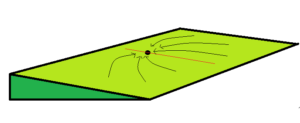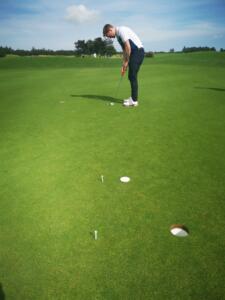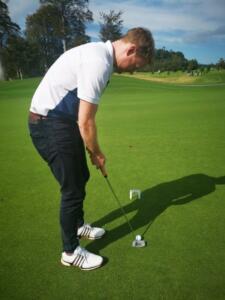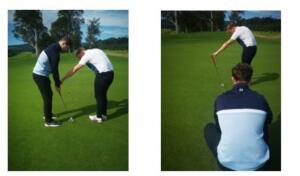General Putting Thoughts
A lot of golfers would like to be better players, but for all those who are motivated by this a good number will not have a plan of where or how this improvement could be made. Putting is one of those areas that rather than formulating good strategies for improvement, so often people move from quick fix to quick fix, this cycle can lead all too easily to frustration, confusion and in some case regression. Because putting is an area that is perhaps a lot more individual in terms of method than other parts of the game it’s easy to feel that answers can be found ad hock. For example we might decide to buy the latest new putter that is in vogue to help improve things and although this may help refresh the mentality in some cases the style and design may not match into the underlying problem. All parts of the game are individual but putting like the full swing and chipping has components that are common to all and knowing your competence and specifically working at the components that are letting your putting down, for me seems like a plan that at least is individual to you.
Teaching, training and learning methods will vary in any areas of life and golf has loads of different ideas and opinions but I have had the thoughts about putting for over 30 years now that regardless of method a golfer needs to be competent in 3 areas when it comes to putting.
- Green reading
- The ability to start the ball on an intended line
- The skill of pace control
Of course, in an article like this it’s impossible to go through all the different things in people’s methods that may have a bearing on the above components. However if a golfer went and tested and analysed each of these things and took a realistic or honest view about this you may find that you may be good at one or two of the components but poor at the other and this could be an easy way to start a plan of how to get better in this area. Remember your practice should have good feedback and your improvement comes from your ability to react to it.
Green Reading
Generally speaking, this is an area that a lot of golfers don’t practice enough. Here are a couple of thoughts. If you can find a hole on a bit of slope and about 6 feet approx. in length away, try and first see if you can work out where the straight putt
is (red line). Then test the putt to see if you are correct. Once you know where the straight line it’s not difficult at least to work out which way the ball will break either side of this line.

If you find a side hill putt and pick & mark your start line, then a few feet short of the hole. Place a large ball marker or “fake hole” on the line that the ball must pass through to go into the proper hole. Then go back and see if your start line mark matches in with fake hole as well. You can hit putts to test out your observations but in broad terms a lot of golfers will under break putts or not put the start line marker high enough.

Start Line
The ability to hit a ball on the intended line consistently is I would think one of the biggest differences between world class putters and the rest of us. I think this is the biggest indicator of technical effectiveness in putting but that doesn’t mean that everybody has to have the same technique, but it does mean that they maybe a number of different things a golfer can do to improve this area. Not hitting the correct line may of course simply be related to poor green reading skills. Another area that is very common is clubface alignment and perceived line can be making putting more difficult than it needs to be. Of course it’s possible for somebody to develop a high level of skill in aiming the face at address off line then compensating for this during the stroke to adjust and at impact to have the face directed correctly – but I would think this is making putting more complex and in my experience is shown up at the 7 to 12 foot range especially under pressure. (Remember if you have a straight 8-foot putt, the face only needs to be offline at impact by 1 degree to miss the putt).
Using “gates” or intermediate targets along a straight-line putt on the practice green is a good way to see if you have consistency in this area.

The next thing is to check your alignment of the face at address. Unless you have equipment like a laser pointer the easiest way is to get somebody else to look along the line and tell you where the club is pointing or alternatively take your set up and then get someone to hold the putter still and go behind and check to see where it is pointing yourself. If you find it is offline sometimes a simple adjustment to your posture and eye line at address can help you.

Pace Control
If start line is the biggest indicator of technical effectiveness, then for me pace control is more of a skill indicator. This doesn’t mean that our technique won’t affect this area because it certainly will. Controlling things like swing path and vertical arc as well as centeredness of impact will influence our ability to control the speed of our putt. It should also be said although perhaps a bit more obvious is our green reading skills will shape our thoughts in relation to pace control. However, this being said our capacity to develop good rhythm in our stroke has a major role in our proficiency to be able to adjust to the different demands of putting distances. Quite often one of the things I notice is that putting stroke backswing length stays the same regardless of the length of putt, this will then lead to a sudden quickening of the clubhead (flashspeed) to get the extra length, so we now have a different rhythm to the stroke. The other thing that is noticeable sometimes is the backswing for longer putts is too slow. If you need to hit a ball further then the backswing speed needs to be a bit quicker to maintain a consistent rhythm.
It’s the same within any area of your game – if you want to improve find out what you are good at and find out what is letting you down then it’s easier to come up with practice ideas that suit you and your game.
“Would you tell me please, which way I ought to go?” said Alice.
“That depends on where you want to get to,” said the cat.
“I don’t much care where-”, said Alice.
“Then it doesn’t matter which way you go” said the cat.
” So long as I get somewhere” said Alice.
“Oh, you’re sure to do that,” said the cat, “if you only keep walking”.
Lewis Carroll – Alice in Wonderland


